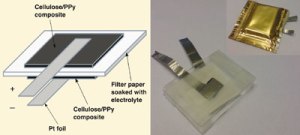 Researchers at the Uppsala University in Sweden have developed a new thin-film battery made from salt and cellulose. This salt and paper battery uses a thin-film which makes it an attractive feature for many portable devices that draw a low current. It can be used in many low-power devices, such as wireless sensors, smart cards, medical implants and RFID tags.
Researchers at the Uppsala University in Sweden have developed a new thin-film battery made from salt and cellulose. This salt and paper battery uses a thin-film which makes it an attractive feature for many portable devices that draw a low current. It can be used in many low-power devices, such as wireless sensors, smart cards, medical implants and RFID tags.
The cellulose is derived from a polluting alga found in lakes and seas. The alga’s walls contain cellulose that has a different nanostructure, which gives it 100 times the surface area. The lightweight, rechargeable battery is made by coating the paper, made from this cellulose,with a conducting polymer, and inserting a salt-solution-soaked filter paper between the paper electrodes.
In comparison with a lithium battery that would take 20 minutes to recharge, this new battery can be recharged in tens of seconds because the ions flow through the thin electrode quickly. The salt and paper battery will be made available to distributors in about three years. For the moment it is still in the early stages of development.
[Source: Physorg]
































